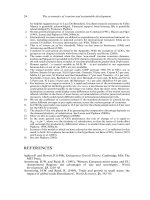THE ECONOMICS OF MONEY,BANKING, AND FINANCIAL MARKETS 372
Bạn đang xem bản rút gọn của tài liệu. Xem và tải ngay bản đầy đủ của tài liệu tại đây (38.22 KB, 1 trang )
340
PA R T I V
The Management of Financial Institutions
OF F- BAL AN CE- SHE E T ACT I VI TI E S
Although asset and liability management has traditionally been the major concern
of banks, in the more competitive environment of recent years banks have been
aggressively seeking out profits by engaging in off-balance-sheet activities. Offbalance-sheet activities involve trading financial instruments and generating
income from fees and loan sales, activities that affect bank profits but do not
appear on bank balance sheets. Indeed, off-balance-sheet activities have been
growing in importance for banks: the income from these activities as a percentage
of assets has nearly doubled since 1980.
Loan Sales
One type of off-balance-sheet activity that has grown in importance in recent years
involves income generated by loan sales. A loan sale, also called a secondary
loan participation, involves a contract that sells all or part of the cash stream from
a specific loan so that it no longer is an asset on the bank s balance sheet. Banks
earn profits by selling loans for an amount slightly greater than the amount of the
original loan. Because the high interest rate on these loans makes them attractive,
institutions are willing to buy them even though the higher price means that they
earn a slightly lower interest rate than the original interest rate on the loan, usually on the order of 0.15 percentage points.
Generation of
Fee Income
Another type of off-balance-sheet activity involves the generation of income from
fees that banks receive for providing specialized services to their customers, such
as making foreign exchange trades on a customer s behalf, servicing a mortgagebacked security by collecting interest and principal payments and then paying them
out, guaranteeing debt securities such as banker s acceptances (by which the bank
promises to make interest and principal payments if the party issuing the security
cannot), and providing backup lines of credit. There are several types of backup
lines of credit. The most important is the loan commitment, under which for a fee
the bank agrees to provide a loan at the customer s request, up to a given dollar
amount, over a specified period of time. Credit lines are also now available to bank
depositors with overdraft privileges these bank customers can write cheques in
excess of their deposit balances and, in effect, write themselves a loan.
Off-balance-sheet activities involving guarantees of securities and backup
credit lines increase the risk a bank faces. Even though a guaranteed security does
not appear on a bank balance sheet, it still exposes the bank to default risk: if the
issuer of the security defaults, the bank is left holding the bag and must pay off
the security s owner. Backup credit lines also expose the bank to risk because the
bank may be forced to provide loans when it does not have sufficient liquidity or
when the borrower is a very poor credit risk.
Banks also earn fees by creating financial instruments like the structured investment vehicles (SIVs) mentioned in Chapter 9 and selling them off to investors.
However, as became clear during the subprime financial crisis of 2007 2008, when
they decline in value, many of these financial instruments have to be taken back
onto the balance sheet of the bank sponsoring them, because to do otherwise
would severely damage the reputation of the bank. Even though these financial
instruments at first appear to be off-balance-sheet, in reality they are back on the
balance sheet if they are subject to large losses. To their regret, banks ended up
taking large losses on these financial instruments during the subprime financial crisis, indicating that these off-balance-sheet vehicles exposed banks to just as much
risk as if they had been part of the balance sheet at the outset.









